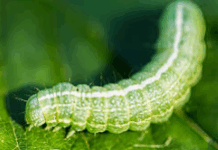
2014 Fall Forestry Field Day focuses on dual-crop systems and stewardship.
MANHATTAN, Kan. — Often times a conservation practice can look great on paper but real-world implementation can be a struggle. Each piece of land is unique with it’s own set of problems that need to be addressed to meet it’s needs, which is why innovation is so important to managing woodlands.
Whether a landowners need some inspiration or just wants to witness forest and wildlife improvement projects first hand, they can find it all at the 20th Annual Fall Forestry Field Day on Oct. 16, 2014.
Alley-Cropping for Breakfast
Beginning at John and Karen Buchanan’s tree farm, located 3 miles southwest of Valley Falls, Kansas, participants can see for themselves why the Kansas Forestry Association has named them the Kansas 2014 Agroforestry Award winners.
“Buchanan’s Tree Farm exhibits one of the most successful agroforestry alley cropping practices in the state,” said Robert Atchison, rural forestry coordinator for the Kansas Forest Service (www.kansasforests.org). “The most common and traditional agroforestry practices in Kansas tend to be shelterbelts and riparian buffers.”
But the Buchanan’s operation stands out across the state. By establishing an alley cropping system they are able to harvest the native grass hay while simultaneously growing potentially high-value trees.
Atchison said the benefits from this practice are numerous. This alley-cropping system provides annual income from the hay crop, grows long-term potential income from the forest products, reduces soil erosion and non-point source pollution and creates a habitat for wildlife.
“What is so unique about the Buchanan’s Tree Farm is the level of detail and attention they have put into aspects such as site preparation, tree planting, fertilization and weed control,” said Atchison. “It’s these things and other follow-up maintenance practices that make alley-cropping successful.”
Throughout the morning, John Buchanan along with a variety of foresters, wildlife biologists and natural resource professionals will share more information about establishment, maintenance and benefits of alley-cropping systems.
Afternoon at the Lake
A catered lunch will be offered as part of the registration fee. Following lunch the field day will move to the US Army Corp of Engineer’s wildlife area on the northwest shores of Perry Lake.
Afternoon sessions will include topics on the issues of the sedimentation of Perry Lake and other reservoirs, water quality and quantity issues facing the state, activities of local watershed groups to address the problem, wildlife food plot establishment and quail habitat management.
The program will also include the presentation of the 2014 Forest Stewardship Outstanding Tree Farmer of the Year Award to Frank Martin. Located in Leavenworth County, the Martin Tree Farm has been certified green by the American Tree Farm System for the past 35 years for its commitment to stewardship and sustainability.
Register Today
Registration may be accomplished by sending a $12 check to the Kansas Forest Service at 2610 Claflin Rd., Manhattan, KS 66502, and writing “Fall Forestry Field Day” in the memo line. A brochure of the event is available on the web at www.kansasforests.org/documents/news/calendar/FFD%20Brochure%202014pub.pdf.
Additional questions may be directed to Bob Atchison at 785-532-3310 or atchison@ksu.edu.
Story By: Kaitlin Morgan




